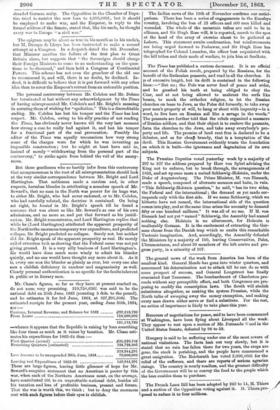Mr. Chase's figures, so far as they have at present
reached us, do not seem. very promising. 219,758,636/. was said to be the
national debt on 30th June, 1863 (counting 5 dols. to the pound), -and he estimates it for 3rd June, 1861, at 837,391,308/. The -estimated receipts for the present year, ending June 30th, 1864, Are :- Customs, Internal Revenue, and Balance for 1868 £32,313,720 From Loans 118,800,000 151,118,720 —whence it appears that the Republic is raising by loan something like four times as much as it raises by taxation. mates his expenditure for 1863-61 thus :- Mr. Chase esti-
First Quarter (actual)
£35,220,186 Remaining Quarters (estimated) 184,724,005
219,944491 Less Amount to be unexpended 30th June, 1864 70,000,000 Leaving real Expenditure of 1863-64 149,944,291 These are large figures, leaving little glimmer of hope for Mr. Seward's sanguine statement that no American is poorer by this war, when each of the Northern Americans must, on the average, have contributed 20/. to an unprofitable national debt, besides all his taxation and loss of profitable business, present and future. That the war is worth this, we think ; but to deny the enormous cost with such figures before their eyes is childish.
The Indian news of the 19th of November confirms our antici- pations. There has been a series of engagements in the Ensassya country, involving the loss of 23 officers and 500 men killed and wounded. The whole of the mountain tribes are said to be in alliance, and Sir Hugh Rose will, it is reported, march to the spot at the head of the army of exercise about to be gathered at Lahore. This statement awaits confirmation, but reinforcements are being urged forward to Peshawar, and Sir Hugh Rose has telegraphed for Colonel Lumsden, the officer best acquainted with the hill tribes and their mode of warfare, to join him at Sealkote.






























 Previous page
Previous page